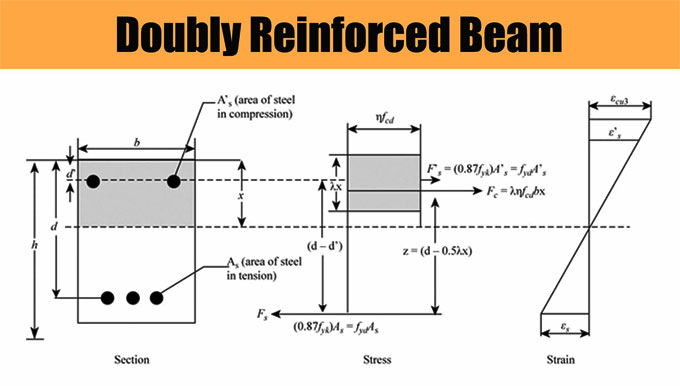
How to design Doubly Reinforced Beams

Concrete has quite high compressive strength, but low tensile strength. However, steel has very high tensile strength. That is why we insert steel reinforcements in the tension zones of a structure.
Now, you can provide reinforcements in concrete beams in two ways - single reinforcement (commonly used) and double reinforcement. Today, we will talk about doubly reinforced beams.
In case of doubly reinforced beams, steel reinforcements are inserted into both the tensile and compression zones of a beam. Meaning, at the top and the bottom of the beam. In contrast, the singly reinforced beams have reinforcements only at the bottom, where it needs tensile support.
Further, in singly reinforced beams, there are two steel bars to be provided, but you need not consider the moment of resistance. However, when you do need to consider this, you have to provide additional bars to reduce the tension in the over-reinforced section.
In case of doubly reinforced beams, though, the matter is quite different. In this case you will have to find out the moment of resistance first! Then, you need the area of tension steel (Ast) and area of compression steel (Asc). Combined, they would overcome the Excess Bending Moment (Mu2).
Designing doubly reinforced beams
When we begin designing a doubly reinforced beam, we need to be careful about some factors. For example, the depth of the beam may need to be limited to given values, be it for architectural reasons or otherwise.
If that is the case, you will have to implement the doubly reinforced beam with the requirement to resist more than standard limiting moment in that confined space you have for it. As a general rule of thumb, we design doubly reinforced beams when the go-to design moment of resistance is higher than that of the limiting moment of resistance.
The beam can be defined as a structural member that carries all vertical loads and resists bending. There are several types of materials used for beams, such as steel, wood, fibers, etc. But the most common material is reinforced concrete.
This type of beam is provided mainly when the depth of the beam is restricted. If a beam with limited depth is reinforced only on the tension side, it may not be strong enough to withstand the bending moment.
The resistance moment cannot be increased by increasing the amount of steel in the stress zone. To increase, the beam is reinforced, but not more than 25%, on the tensioned side.
Thus, a doubly reinforced beam is provided to increase the strength moment of a beam with limited dimensions. Steel reinforced beams in compression and tension zones are called doubly reinforced beams.
Beams reinforced with steel in compression and tension zones are called doubly reinforced beams.
This type of beam will be found necessary when due to head room consideration or architectural consideration the depth of the beam is restricted. The beam with its limited depth, if reinforced on the tension side only, may not have enough moment of resistance, to resist the bending moment.
By increasing the quantity of steel in the tension zone, the moment of resistance cannot be increased indefinitely.
Usually, the moment of resistance can be increased by not more than 25% over the balanced moment of resistance, by making the beam over-reinforced on the tension side. Hence, in order to further increase the moment of resistance of a beam section of unlimited dimensions, a doubly reinforced beam is provided.


